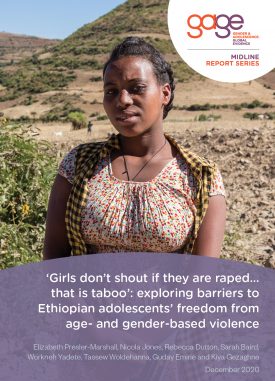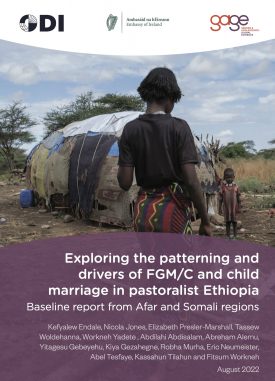Age- and gender-based violence during adolescence is widespread, and the risks permeate all spheres of adolescents’ lives – family and marriage, schools, peer networks and communities. Yet this violence affects girls and boys very differently within and across low- and middle-income country (LMIC) contexts. Midway through the Sustainable Development Agenda, data from the Gender and Adolescence: Global Evidence (GAGE) research programme reinforces the urgency of investing in a tailored, adequately resourced package of interventions, coordinated across sectors and development actors. This would allow the global community to make meaningful progress towards Sustainable Development Goals (SDGs) 5 and 16 to eliminate all forms of violence affecting young people.
This brief draws on data collected in three of GAGE’s core countries: Bangladesh, Ethiopia and Jordan using mixed-methods research. GAGE findings highlight that adolescent girls – and boys – regularly face myriad forms of age- and gender-based violence. Risks are context-dependent, which in some cases means adolescent girls and boys do not perceive what they are experiencing as violence, and in other cases leads them to embrace such behaviour because it demonstrates to their peers and communities that they are conforming to social norms. Critical to tackling this violence is a recognition that age-based violence is often deeply gendered; that gender norms leave girls and boys at heightened risk of different types of violence; and that sometimes the best way to support girls to lead lives free of violence is to ensure that the boys in their environments are also free of violence.
Suggested citation
Presler-Marshall, E., Oakley, E., Abu Hamad, Sh., Diab, R., Jones, N., Abu Hammad, B., Alheiwidi, S., Yadete, W., Seager, J., and Baird, S. (2022) ‘Adolescent girls’ and boys’ experiences of violence: evidence from Gender and Adolescence: Global Evidence (GAGE)’. Policy brief. London: Gender and Adolescence: Global Evidence. (https://www.gage.odi.org/publication/adolescent-girls-and-boys-experiences-of-violence-evidence-from-gender-and-adolescence-global-evidence-gage/)


